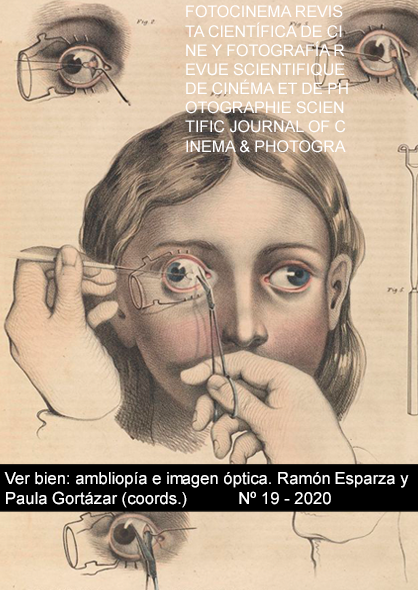Amblyopia
DOI:
https://doi.org/10.24310/Fotocinema.2019.v2i19.6677Keywords:
Photography, AmblyopiaAbstract
But like everything related to our vision, amblyopia is certainly complex term both to delimite and define. What does it exactly mean to ‘see right’? At present, I am writing this text as I see it through my computer screen, which has a resolution way higher than that of the analogue television we used to watch during our childhood years. But higher resolution undoubtly involves more information that needs to be captured by our sight and later processed by our brains. Just like it happens when comparing old gravure printing techniques with high-end image printing processes from the present time, the reproduction of certain details in the image and the range of colorous and tones prensent in contemporary photographic prints are often wider than those which the human eye is able to perceive. But would have short-sighted people had the need to use spectacles two centuries ago? Or was the level of deail present in printed (and painted) material vague enough to be perceived by a much larger scope of the population?
Downloads
Metrics
References
Renger-Patzsch, A. (1989). Aims. In Phillips, C. Photography in the modern era. New York: Aperture.
Smith, P. (2013). Cezanne’s “Primitive” Perspective, or the “View from Everywhere”. Art Bulletin. Volumen XCV, 1, march.
Wade N. J. (1998). A natural history of vision. Cambridge: The MIT Press.
Downloads
Published
How to Cite
Issue
Section
License
All contents published in Fotocinema Revista científica de cine y fotografía are protected under the Creative Commons Attribution-NonCommercial-ShareAlike 4.0 International (CC BY-NC-SA 4.0) license. All about this license is available in the following link: <http://creativecommons.org/licenses/by-nc-sa/4.0>
Users can copy, use, redistribute, share and exhibit publicly as long as:
- The original source and authorship of the material are cited (Journal, Publisher and URL of the work).
- It is not used for comercial purposes.
- The existence of the license and its especifications are mentioned.
There are two sets of authors’ rights: moral and property rights. Moral rights are perpetual prerogatives, unrenounceable, not-transferable, unalienable, imprescriptible and inembargable. According to authors’ rights legislation, Fotocinema. Revista científica de cine y fotografía recognizes and respects authors moral rights, as well as the ownership of property rights, which will be transferred to University of Malaga in open access. The property rights are referred to the benefits that are gained by the use or the dissemination of works. Fotocinema. Revista científica de cine y fotografía is published in an open access form and it is exclusively licenced by any means for doing or authorising distribution, dissemination, reproduction, , adaptation, translation or arrangement of works.
Authors are responsable for obtaining the necessary permission to use copyrighted images.













13.png)



